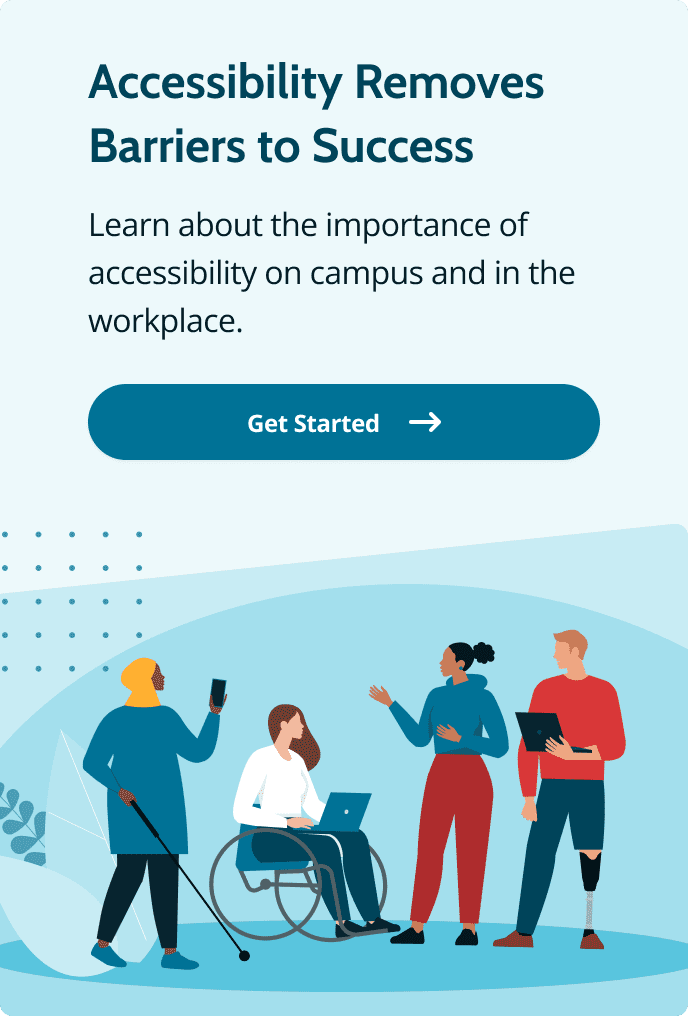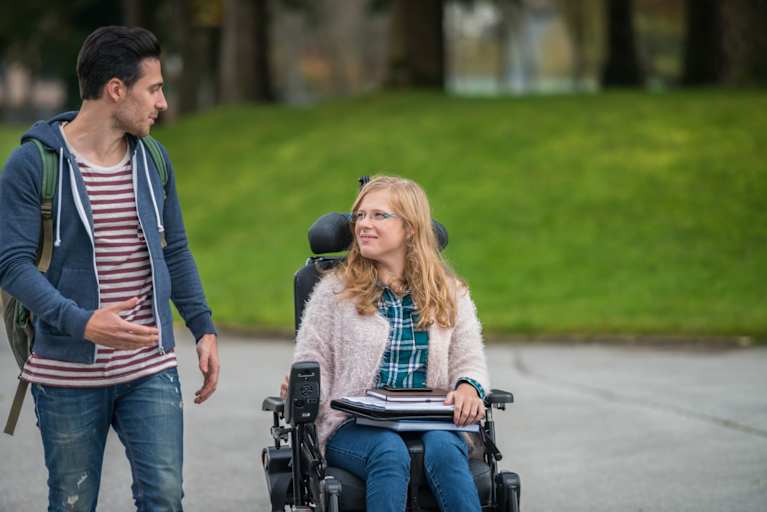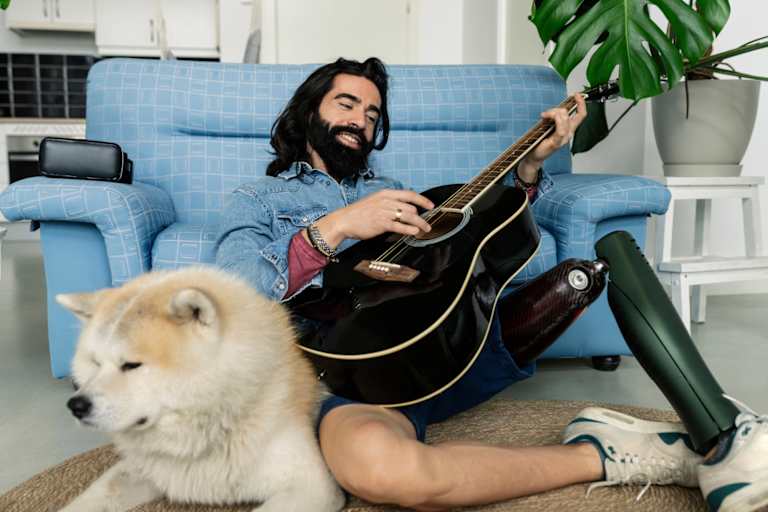Professional Guide for Working With Students With Disabilities
- Disability is a social construct with varying definitions.
- Approximately 1 in 5 American adults identifies as disabled.
- Students with disabilities can be enabled by accommodations such as assistive technology.
- This guide offers strategies for disability inclusion.
Approximately 1 in 5 American adults identifies as disabled. Disability is a social construct with various definitions. The Americans with Disabilities Act (ADA) defines disability as “a physical or mental impairment that substantially limits one or more major life activity.”
Many disabled people follow the social model of disability, which was created by disabled disability rights advocates. This model views disability as a result of how a person interacts with their environment. Society disables people through its designs, created for typical bodyminds, and how people behave within those designs.
Viewed this way, disability is alleviated by appropriate inclusion efforts. For example, disabled college students can be enabled when they receive appropriate accommodations. Read this guide to learn more about how to practice inclusion with disabled students.
People-First Language vs. Identity-First Language
Some disabled people prefer person-first language, while others use identity-first language. Identity-first language, popular in the Deaf and Autistic communities, sounds like “disabled person,” “Deaf person,” or “Autistic person,” and is used by many disabled people to illustrate that disability is inseparable from their identity.
Person-first language places the word “person” before the disability and sounds like “person with autism.” Person-first language is meant to show disability as merely a label rather than a defining characteristic of a person, although many disabled people feel that disability defines them, much like many people feel that other social constructs such as gender define them. While it’s important to consider disability culture, disabled people are not a monolith; the inclusive practice is to ask each individual what language they prefer.
Guidelines for Proper Etiquette
Mobility Disabilities
When interacting with people who use wheelchairs and other mobility devices, avoid unnecessarily drawing attention to their disability. Never assume someone needs help, and it’s best to avoid touching someone’s equipment or entering their personal space without permission. Inclusive practice means saying that someone uses a wheelchair, rather than they are “confined” to a wheelchair.
Blindness and Visual Disabilities
It’s important to avoid invading the personal space of someone with visual limitations. This includes seeing-eye dogs, who you should only interact with after getting the person’s consent. Only act as a sighted guide after verbally requesting permission. If permission is granted, a sighted guide should verbally offer their arm or hand and slightly brush it against a blind person’s hand.
Deafness and Hearing Disabilities
Establish communication boundaries with someone who has hearing limitations by asking them their preferences, speaking as you would speak to any nondisabled person. Keep in mind that if a student was born Deaf, American Sign Language (ASL) is likely the first language they learned. This means that verbal language isn’t their first language. They may struggle with speaking or writing. They may also be well-versed in lip-reading. Refrain from brushing off a person’s request to repeat a word or phrase, even if it happens multiple times.
Cognitive Disabilities
You may not know a student has a cognitive disability until they disclose their disability to you. Cognitive disabilities are neurodivergences. This means that they have a neurological landscape, or neurotype, that differs from most people, who are called neurotypical. Avoid pathologizing a neurodivergent person by talking down to them or referring to their neurotype as an illness or disorder. Never impose social norms such as eye contact, small talk, or handshakes on someone who seems disinterested or resistant.
Speech Disabilities
People with speech disabilities often experience ableism for the ways they present. As you should with a neurodivergent person, assume competence when talking to someone with a speech disability. Disability never means that a person is less intelligent or capable than someone without a disability. Disability often just means someone has to discover new ways to reach their goals. Avoid interrupting them and attempting to finish their thoughts or sentences. Also avoid shouting or unnecessarily repeating yourself.
Accommodating Students With Disabilities
Assistive Technology
Thanks to the Assistive Technology Act, disabled students can request adaptive technology as an accommodation. Assistive or adaptive technology makes information, tasks, and activities accessible to students who struggle to learn in traditional environments. It includes time-blocking software, word prediction apps, augmentative and alternative communication, eye-tracking software, and hardware such as ability switches, large print keyboards, and Braille displays.
In-Class Modifications
In-class modifications include assistive technologies, such as relay services, which enable Deaf students to take and place phone calls, and closed-captioning. Deaf students also benefit from ASL interpreters. Students with various disabilities can benefit from visual-based teaching methods, additional test time, note-takers, scribes for exams, computers for essay exams, and audio recorders for recording lectures.
Learning Aids and Devices
Learning aids are common college accommodations. Students who read Braille may request specialized course materials. Assistive technology, such as dictation software and devices, also benefits students with visual limitations or speech and writing challenges. Supplemental learning aids and devices, while permitted in the classroom, should be provided in a student’s 504 plan, which they create with disability services.
Spatial Modifications
Mobility device users, including wheelchair users, may request spatial modifications if they find their classroom inaccessible. Instructors may also reserve seats in the front row for students with limited mobility, including students who are temporarily disabled, and for students with visual and hearing limitations. Instructors can request a classroom change if classroom modifications are ineffective.
Scent or Fragrance-Free Zones
Many people with disabilities benefit from fragrance or scent-free zones, which are free from smoke, fragrance, and harsh chemicals. Scent-free zones benefit people with visual disabilities, those who’ve experienced hearing loss or are Deaf, and those with sensory sensitivities and cognitive disabilities. People using these areas should avoid bringing food with strong odors.
Universal Design for Instruction (UDI)
UDI refers to instruction designed for students from all backgrounds and identities. Instructors who apply UDI frameworks to their classrooms aim to create environments that are accessible to all students, including students with disabilities. A teacher who applies UDI teaching methods enables students with different learning styles, reading levels, neurotypes, ethnicities, and native languages to learn together.
Resources for Working With Students With Disabilities
ADA.gov
The U.S. Department of Justice is located online at ADA.gov, where users can locate resources and training for working with disabled students. The website offers a form where users can file disability discrimination complaints, as well as in-depth information about disability discrimination legislation.
Disability Scoop
Disability Scoop describes itself as “The Premier Source for Developmental Disability News.” This site has been featured in major media venues, including the Washington Post, USA Today, and Politico, offering the latest news about education, health, politics, and law, among other disability-related topics.
Top College Consultants
Top College Consultants helps neurodivergent students navigate college admissions. Their aim is to “expand access to college for students worldwide, especially those with learning differences and emotional challenges.”
The National Inclusion Project (NIP)
NIP partners with community organizations and recreational programs, “providing them with the training, tools, and support” to include disabled children in “all of their activities and programs.”
Association on Higher Education and Disability (AHEAD)
AHEAD is a professional organization of over 4,000 professionals committed to helping college students navigate employment after graduation. Membership grants you access to their professional community, a legal database, and discounts on conferences and other events and resources.

Frequently Asked Questions About Working With Students With Disabilities
How do you address students with disabilities?
You never know how a person identifies unless you ask. A disabled person may prefer to be called disabled, which is identity-first language. Identity-first language empowers many disabled people by illustrating disability as inseparable from their identity. Some disabled people, however, prefer person-first language, which shows that disability is simply a label rather than their full identity.
It’s important to learn about disability culture, but inclusion means seeing each person as not only an equal, but also as an individual — and treating them as such. The best way to address any disabled person is to ask them what language they prefer, then stick to that language.
How do you introduce someone with a disability?
Introduce a disabled person the way you’d introduce anyone. Say their name or/and their relationship to you. If you need to mention their disability, refer to their disability using the language they prefer. Remember that disability, like gender, is a social construct.
People with disabilities constitute a minority social group that has been marginalized. Like any marginalized people, people with disabilities want an end to the discrimination they experience and to be treated respectfully, as equals.
What should you not say to someone with a disability?
Disability is not a tragedy. Therefore, it’s never appropriate to pathologize a disabled person. To pathologize is to label someone as abnormal. This is wrong because there is no “normal” bodymind any more than there is a “normal” gender. Avoid saying that someone “suffers from” a disability, or that someone is “confined to” mobility equipment. Also, avoid showering a disabled person with pity.
Similarly, it’s inappropriate to shower a disabled person with praise for simply living their life. Avoid telling disabled people that they are “brave” or “inspiring.” Instead, treat them like the individuals they are.


